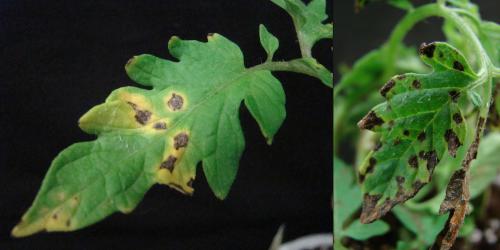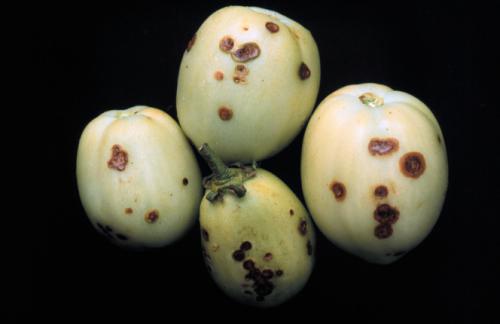Protect greenhouse tomato transplants from bacterial spot
Tough love in the greenhouse means less heartbreak in the field from bacterial spot.

Three important diseases of Michigan’s tomatoes result from infection by bacteria and include bacterial canker, bacterial speck, and bacterial spot. In recent years, bacterial spot disease has caused devastating losses to growers producing fruit either for the fresh market or for processing. Bacterial spot affects the fruit and results in brown-black corky lesions that may be somewhat sunken. These spots cause tomato fruit to be unmarketable. Even fruit targeted for processing may become unusable because the spots prevent the skin from slipping off. Yield loss can occur if the foliage becomes heavily diseased and blighted. As portions of the foliage die from bacterial spot, sunscald of the fruit commonly occurs.
Steps to prevent bacterial spot must start early in the season. This pathogen can be seedborne, so early leaf spotting may appear on seedlings while in the greenhouse. Bacteria spread from plant to plant with water, most often via splash droplets from overhead watering. Since bacteria prefer warm, wet environments, transplants growing in a greenhouse offer a perfect home for bacterial spot.
Bacterial spots on transplants can mimic Alternaria leafspot, and certain growing stresses. Look for these common bacterial spot symptoms:
- Small, dark brown/black spots with a yellow halo
- Blotchy spots on the leaf and stems
- Spots with tan centers

Figure 1. Bacterial spot on tomato leaves: left, dark spots with a yellow halo; right, dark, blotchy spots. Photo: Mary Hausbeck, MSU.

Figure 2. Bacterial spot on tomato fruits. Photo: Mary Hausbeck, MSU.
The earlier that diseased transplants are identified and removed from the greenhouse, the better. Transplants are grown in tightly-packed transplant trays to maximize greenhouse space. Since the pathogen that causes bacterial spot moves via splash droplets, not only should the obviously diseased transplants be removed from the greenhouse and disposed of in the dumpster, but the plug flats adjacent to the diseased plants should also be removed. Plants can be infected with low levels of bacterial spot and still appear healthy. Research in transplant greenhouses has shown that bacterial pathogens move several feet beyond those plants that are obviously diseased. Regular scouting coupled with quick and decisive action are important parts of a management strategy for bacterial spot. While it may be painful to remove seemingly healthy plants, the diseased transplants cannot be cured and it is unlikely these plants will be healthy and productive if planted in the field.
Greenhouse sanitation is also important. Reusing plug trays from one year to the next is not advised because tomato pathogens, including bacterial spot, could potentially survive and cause problems for new transplants.When removing diseased transplants, also dispose of the plug trays. If you’re using tools, make sure they are sanitized after use. Greenhouse benches and floors can be sanitized by first washing the surface so there is no soil or plant tissue. After washing, the surfaces can be disinfected by using a 10% bleach mix or a commercial sanitizing product. Dousing the surface with the sanitizer is helpful so that there is an extended contact time to help kill any remaining pathogens.
Copper-based products and Agri-Mycin 50 (streptomycin) can be used on tomato transplants in the greenhouse to limit the bacterial spot pathogen. They should be applied to transplants very early and begin when the first true leaves have emerged and reapplied frequently. The time between sprays should be as short as that which is allowed by the product labels. In many instances, the bacterial spot has developed resistance to copper so mixing a copper product with Agri-Mycin 50 is preferred. While there are anecdotal reports that mixing mancozeb with copper is helpful, this concept has not been sufficiently proven. However, since mancozeb provides some protection against Botrytis gray mold and Alternaria leaf blight, it is okay to add it to the copper + Agri-Mycin 50 mix. Choose a copper product that has a relatively high level of metallic copper. Keep in mind that the copper products with a high percentage of this active ingredient will likely also require a longer re-intry interval but this can be addressed by using personal protective equipment as described by the label.
More information on tomato diseases, as well as advice on cultural and chemical controls, can be found in the Midwest Vegetable Production Guide (Michigan State University Extension Bulletin E0312).



 Print
Print Email
Email

